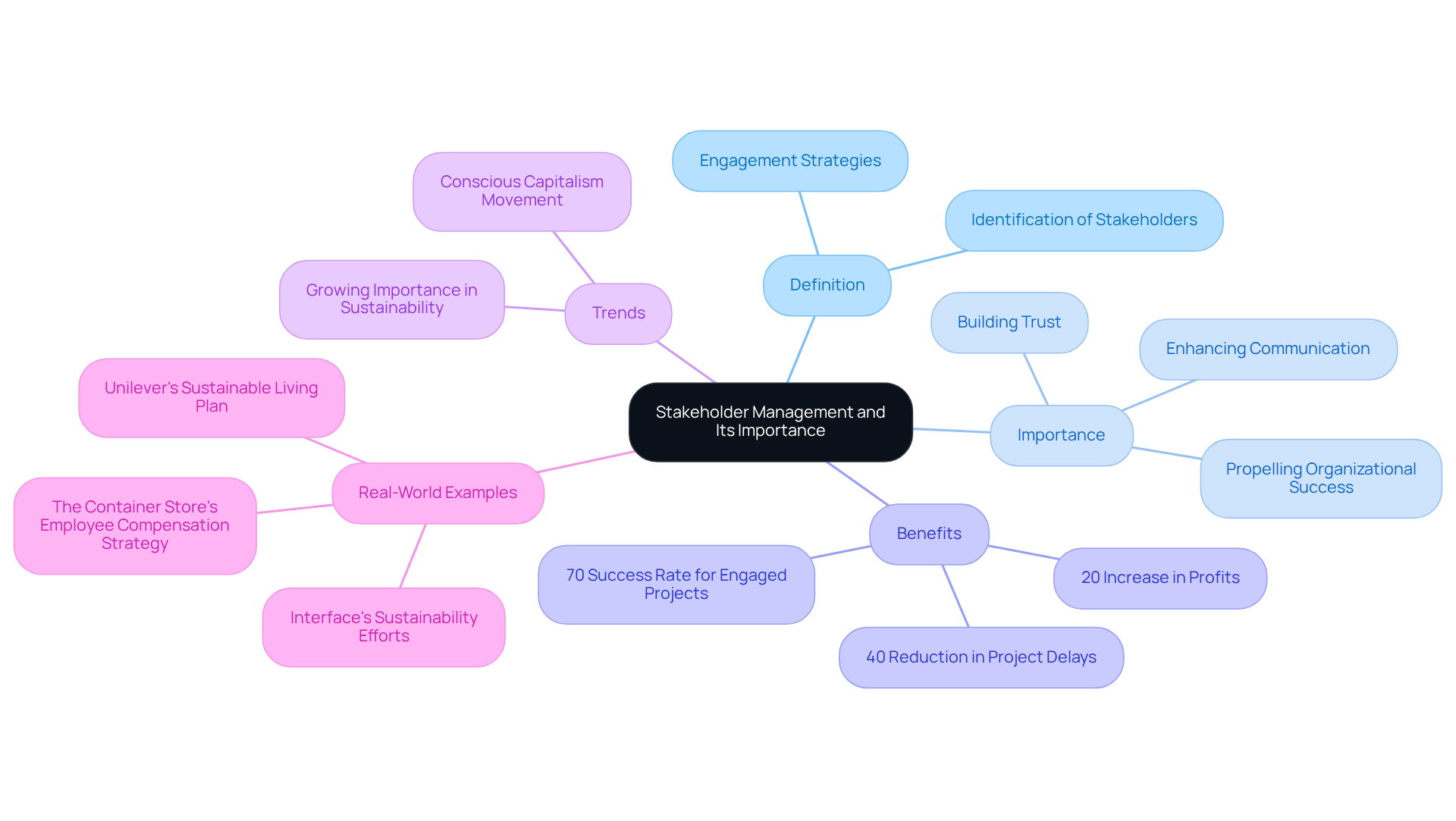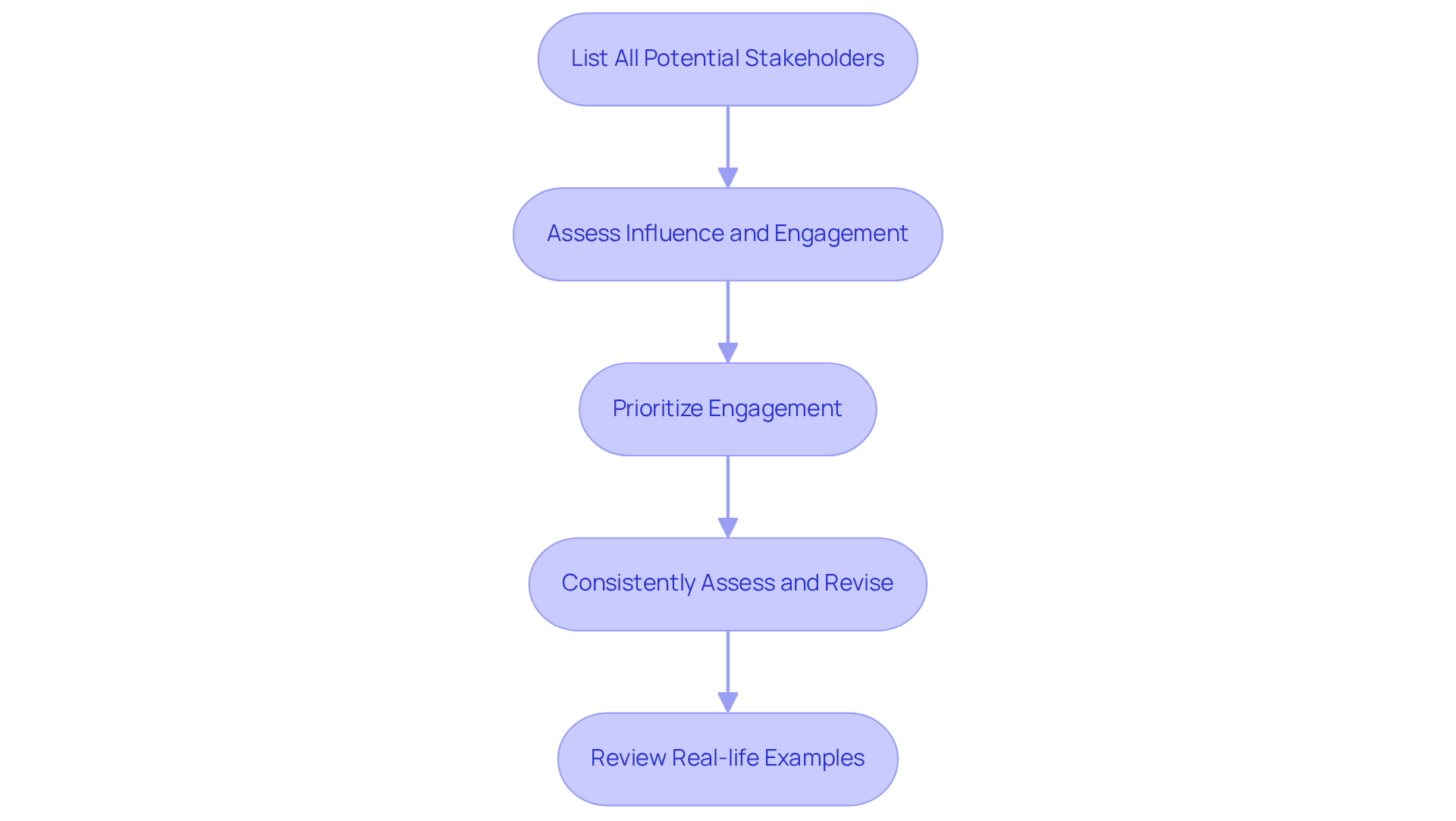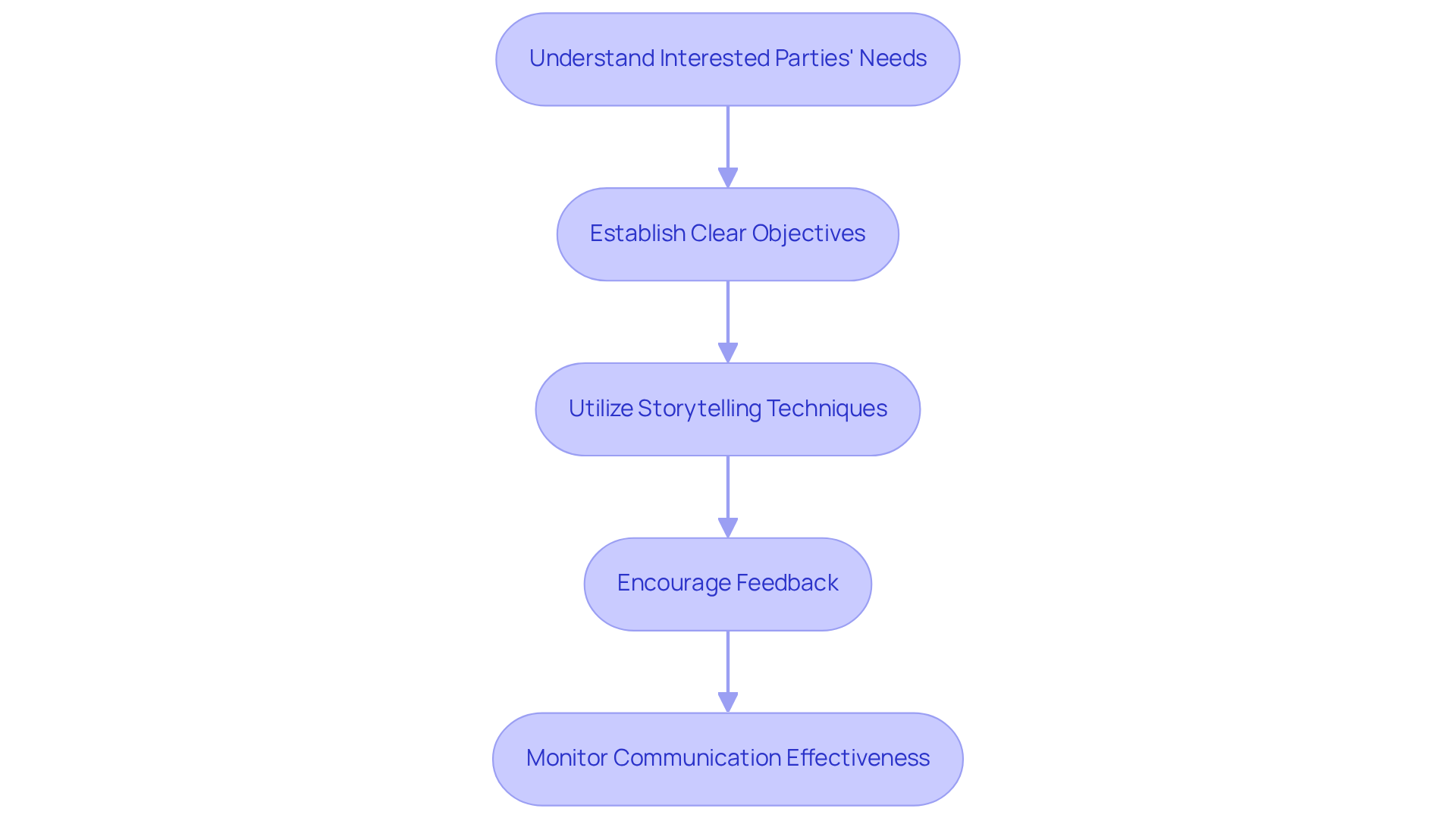Overview
This article presents four pivotal real-life examples of stakeholder management tailored for CFOs, underscoring the critical role of effective engagement strategies in driving organizational success. It delineates how strong stakeholder management can yield substantial advantages, such as heightened profits and minimized project delays, by aligning stakeholder interests with overarching business objectives and cultivating collaborative environments.
Introduction
Stakeholder management is not merely a buzzword; it is a vital element of organizational success that can profoundly impact a CFO's strategic decisions. By comprehensively understanding and engaging with diverse stakeholders—from investors to regulatory bodies—CFOs can drive profitability and improve project outcomes. However, navigating the intricate dynamics of these relationships presents challenges, particularly in today’s rapidly changing business environment.
How can CFOs leverage real-life examples of successful stakeholder management to not only meet but surpass their organizational objectives?
Define Stakeholder Management and Its Importance
Stakeholder management is a strategic process that encompasses the identification, analysis, and engagement of individuals or groups with a vested interest in or impact on an organization or its projects. For CFOs, this means comprehensively understanding the diverse requirements and expectations of stakeholders, including investors, employees, customers, and regulatory bodies. The effective management of these stakeholders is crucial as it builds trust, enhances communication, and propels organizational success.
Research indicates that organizations with robust stakeholder engagement experience a 20% increase in profits and a 40% reduction in project delays, underscoring the tangible benefits of this approach. By aligning stakeholder interests with business objectives, CFOs can create a collaborative environment that not only fosters sustainable growth but also mitigates risks associated with misalignment.
Recent trends in 2025 highlight the increasing importance of stakeholder engagement in achieving sustainability goals, with companies prioritizing these relationships reporting significantly improved financial performance and market reputation. Real-world examples, such as Unilever's Sustainable Living Plan, demonstrate how effective stakeholder management real life examples can lead to accelerated growth and increased brand loyalty, reinforcing the idea that a well-executed engagement strategy is foundational to long-term organizational success.

Identify and Prioritize Stakeholders
To effectively identify and prioritize stakeholders, CFOs should follow these essential steps:
- List All Potential Stakeholders: Begin by compiling a comprehensive list of individuals and groups that may influence or be affected by the organization. This includes employees, customers, suppliers, investors, and regulatory bodies.
- Assess Influence and Engagement: Evaluate each party's level of influence and engagement within the organization. Employing a Power/Influence Grid can be advantageous, classifying participants into four categories: high power/high engagement, high power/low engagement, low power/high engagement, and low power/low engagement. This method enables a clear visualization of participant dynamics, ensuring that those with the most significant impact are prioritized. Furthermore, low power and low engagement parties should be observed with minimal communication to prevent overwhelming them.
- Prioritize Engagement: Involve key individuals in the high power/high interest category first, as they are vital to the organization's success. Tailor engagement strategies to meet the specific needs and expectations of each group. For example, organizations that effectively involve these parties can experience a 20% increase in profits, emphasizing the significance of strategic prioritization. According to HubSpot, 78% of projects succeed with involved participants, highlighting the critical role of their engagement. Moreover, by optimizing decision-making processes and employing real-time analytics through tools such as a client dashboard, CFOs can enhance their engagement strategies, ensuring timely and informed actions that align with the expectations of those involved.
- Consistently Assess and Revise: Participant dynamics are not fixed; therefore, it is essential to consistently assess and revise the list of participants and their prioritization. This guarantees continuous alignment with organizational objectives and adjusts to any changes in participant influence or interest. Ongoing observation via real-time business insights can assist this process, enabling CFOs to assess participant well-being and modify approaches as needed.
Real-life examples of stakeholder management demonstrate the effectiveness of these approaches. For instance, a firm that executed a focused interaction plan grounded in interest group analysis experienced a 25% decrease in project completion time, providing stakeholder management real life examples that illustrate the concrete advantages of prioritizing relationships with key participants. Furthermore, organizations that actively involve participants in decision-making processes report enhanced results and minimized risks, emphasizing the essential role of participant involvement in achieving business success. As Angela Rodgers states, "When you recognize the needs of interested parties and your priority groups from the beginning, you can ensure the appropriate individual receives the proper resources at the right moment.

Develop Effective Communication Strategies
To cultivate effective communication strategies for stakeholder engagement, CFOs must implement the following steps:
-
Understand Interested Parties' Needs: Tailor communication to meet the specific requirements and preferences of each group of interested parties. This may involve utilizing various channels such as emails, meetings, and reports, while adjusting the level of detail according to the audience's familiarity with financial concepts.
-
Establish Clear Objectives: Clearly define the purpose of each communication effort. Whether the goal is to inform, persuade, or gather feedback, stakeholder management real life examples demonstrate that having well-defined objectives will guide the content and delivery of the message.
-
Utilize Storytelling Techniques: Employ storytelling to make complex financial data more relatable and engaging. By presenting financial information within a narrative, CFOs can assist interested parties in grasping the implications of data, fostering a deeper connection and understanding.
-
Encourage Feedback: Create avenues for interested parties to provide feedback on communications. This not only boosts participation but also allows CFOs to improve their approaches based on feedback from interested parties, ensuring that communication stays pertinent and impactful.
-
Monitor Communication Effectiveness: Regularly evaluate the effectiveness of communication strategies through surveys or feedback sessions. This ongoing evaluation will assist in identifying areas for enhancement and ensure that the needs of involved parties are consistently met.

Monitor and Adapt Stakeholder Engagement Practices
To effectively monitor and adapt stakeholder engagement practices, CFOs should implement the following strategies:
- Establish Key Performance Indicators (KPIs): Define specific KPIs to assess the success of participant involvement efforts. Metrics such as participant satisfaction scores, involvement frequency, and feedback quality are crucial for evaluating effectiveness. Companies that excel in engagement plans are 40% more likely to complete projects on time and within budget, underscoring the importance of these metrics.
- Conduct Regular Reviews: Schedule periodic evaluations of participant involvement practices to assess their effectiveness. This entails examining feedback, participation metrics, and overall participant sentiment. Nearly half of government relations specialists allocate 6 to 10 hours each week to interacting with interested parties, emphasizing the necessity for comprehensive assessments. Incorporating real-time analytics through tools like the client dashboard can further enhance these evaluations, enabling CFOs to make informed decisions swiftly.
- Be Open to Change: Maintain flexibility and be willing to adjust involvement strategies based on participant feedback and evolving situations. Modifying communication techniques, frequency, or content can significantly enhance participant satisfaction and engagement.
- Foster a Culture of Continuous Improvement: Cultivate an organizational culture that values feedback and ongoing enhancement in stakeholder interaction. This approach not only yields innovative plans but also strengthens connections over time, as effective interaction practices contribute to broader organizational performance.
- Document Lessons Learned: Keep a comprehensive record of successful engagement strategies and areas for improvement. This documentation serves as a valuable resource for future stakeholder management real life examples, allowing organizations to refine their approaches based on past experiences.

Conclusion
Effective stakeholder management stands as a cornerstone of organizational success, particularly for CFOs who navigate complex relationships with various interest groups. By understanding and engaging stakeholders, CFOs can align their objectives with the broader goals of the organization, fostering an environment of trust and collaboration. This strategic approach not only enhances communication but also drives sustainable growth and mitigates risks.
The article outlines critical steps for CFOs to:
- Identify and prioritize stakeholders
- Develop tailored communication strategies
- Continuously monitor and adapt their engagement practices
Key insights, such as utilizing a Power/Influence Grid for stakeholder assessment and employing storytelling techniques for effective communication, underline the importance of strategic prioritization and adaptability. Real-life examples demonstrate that organizations prioritizing stakeholder engagement can significantly improve project outcomes and financial performance.
Ultimately, the significance of stakeholder management cannot be overstated. It serves as a vital framework for fostering relationships that drive organizational success. CFOs are encouraged to implement these best practices, continually refine their strategies, and embrace a culture of feedback and improvement. By doing so, they not only enhance their own effectiveness but also contribute to the overall resilience and reputation of their organizations in an ever-evolving business landscape.
Frequently Asked Questions
What is stakeholder management?
Stakeholder management is a strategic process that involves identifying, analyzing, and engaging individuals or groups who have a vested interest in or impact on an organization or its projects.
Why is stakeholder management important for CFOs?
For CFOs, stakeholder management is important because it helps them understand the diverse requirements and expectations of stakeholders, such as investors, employees, customers, and regulatory bodies, which is crucial for building trust, enhancing communication, and ensuring organizational success.
What are the benefits of effective stakeholder management?
Effective stakeholder management can lead to a 20% increase in profits and a 40% reduction in project delays, highlighting its tangible benefits in aligning stakeholder interests with business objectives and fostering a collaborative environment.
How does stakeholder engagement relate to sustainability goals?
Recent trends indicate that stakeholder engagement is increasingly important for achieving sustainability goals, with companies that prioritize these relationships reporting significantly improved financial performance and market reputation.
Can you provide an example of successful stakeholder management?
A real-world example of successful stakeholder management is Unilever's Sustainable Living Plan, which demonstrates how effective engagement can lead to accelerated growth and increased brand loyalty, reinforcing the importance of a well-executed engagement strategy for long-term organizational success.




